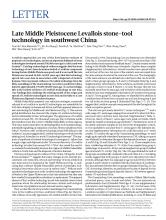Levallois approaches are one of the best known variants of prepared-core technologies, and are an important hallmark of stone technologies developed around 300,000 years ago in Africa and west Eurasia1,2. Existing archaeological evidence suggests that the stone technology of east Asian hominins lacked a Levallois component during the late Middle Pleistocene epoch and it is not until the Late Pleistocene (around 40,000–30,000 years ago) that this technology spread into east Asia in association with a dispersal of modern humans. Here we present evidence of Levallois technology from the lithic assemblage of the Guanyindong Cave site in southwest China, dated to approximately 170,000–80,000 years ago. To our knowledge, this is the earliest evidence of Levallois technology in east Asia. Our findings thus challenge the existing model of the origin and spread of Levallois technologies in east Asia and its links to a Late Pleistocene dispersal of modern humans.
